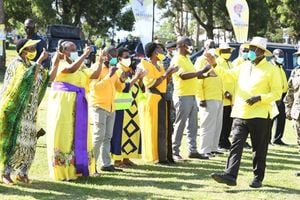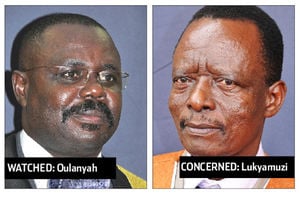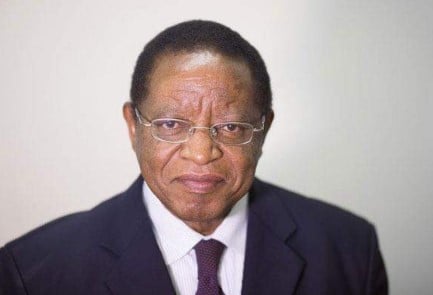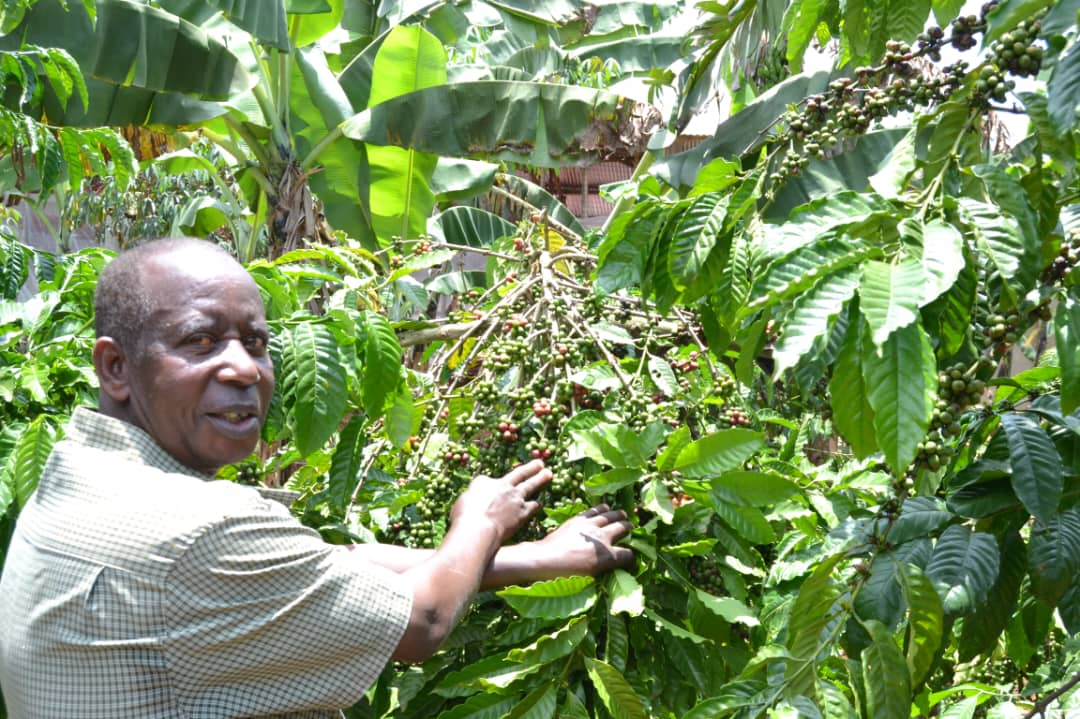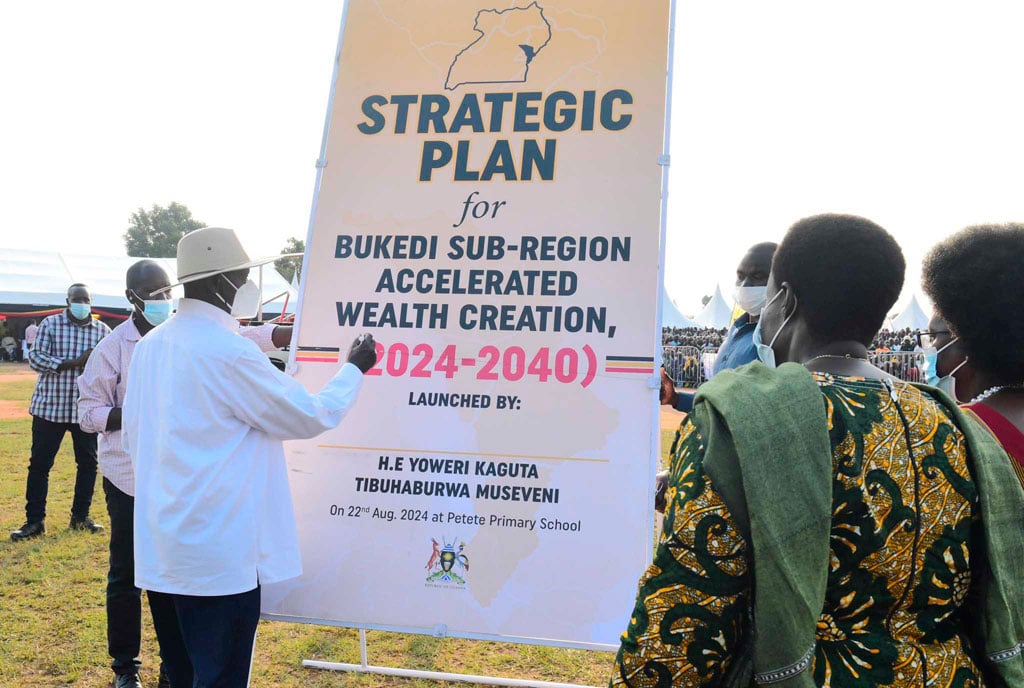
President Museveni launches the Bukedi Sub-region Accelerated Wealth Creation Programme in Butebo District on Thursday, August 22, 2024. PHOTO | PPU
President Museveni will on Monday next week embark on a three-day visit to Bukedi Sub-region as part of his anti-poverty campaign. According to the Deputy Presidential Press Secretary, Mr Faruk Kirunda, the visit, which will commence on November 4 and end on November 6, will focus on initiatives to boost household income.
About 88.3 percent of Bukedi’s households still rely on subsistence farming, and despite several government wealth creation programmes, Bukedi’s poverty rate is 37 percent. The sub-region’s per capita income stands at 43.7 percent, with a GDP per capita of $135 (Shs488,866). Mr Clyan Gimei, a local political analyst, said although the government has had several programmes aimed at poverty alleviation in the sub-region, the situation has not changed much.
“Right from the late 1990s with the Poverty Alleviation Programme, the intentions by Mr Museveni have always been good, but results are disappointing due to mismanagement of these programme. There seems to be sabotage from within that always renders these programmes impotent,” Mr Gimei said.
The government’s programmes to alleviate poverty include the National Agricultural Advisory Services (Naads), the Women Entrepreneurship Programme (UWEP), Operation Wealth Creation (OWC), Youth Livelihood Programme (YLP), Poverty Alleviation Programme (PAP), Poverty Eradication Action Plan (PEAP), and Northern Uganda Social Action Fund (NUSAF). Mr Gimei said Bukedi used to be one of the high producers of cotton and also prided in cattle farming, which have all collapsed.
“The collapse of the dairy cooperation of Mbale and the effects of the war, Bukedi’s cattle farming appears to have died, negatively impacting on the incomes of the sub-region, hence the alarming poverty rates today,” he said. He said the collapse of the affordable railway transport network may have also negatively impacted the economy of Bukedi.
“Most times the leaders who attend Mr Museveni’s meeting present their selfish vested interests camouflaged as the views of the locals. The President is most likely to be taken around the Bukedi to inspect a few projects that are most times staged to impress him,” he said.
Stakeholders said the sub-region lacks a perennial cash crop such as coffee to boost people’s incomes The much-publicised PDM was also launched in Kibuku, one of the districts under Bukedi Sub-region, as part of the effort to fight the high poverty levels in the region. Mr James Wire, an agribusiness consultant, said the government should support the residents on value addition.
“The current practices limit farmers’ earnings. Take, for example, a cassava farmer sells his harvest at Shs300,000 per acre after six months of hard work. This is not sustainable and can[1]not lift people out of poverty,” Mr Wire said.
He said to improve farmers’ livelihoods, the value chain in the sub-region needs restructuring and support, similar to what has been done in western Uganda for milk production. “Farmers in western Uganda used to sell milk at low prices, but through cooperatives, they now operate more effectively. In Bukedi, however, it’s every man for himself,” he said.
Mr Wire said the visit of the President can’t transform the sub-region, but he should address the poor state of roads, which he said are hampering trade in the area.
“Roads are in poor condition, and connectivity is limited. We urge the President to prioritise infrastructure improvements in Bukedi,” he said.
He added, “For instance, rice production is high but the returns remain low. Establishing factories in Bukedi would help improve the value of rice, boosting incomes and improving lives.”
Butaleja District Woman MP Florence Nabanda attributed the region’s continued poverty to the lack of investment in irrigation infrastructure.
“The agricultural sector here is struggling because farmers can’t produce throughout the year. Irrigation would enable them to grow crops in all seasons, drastically reducing poverty,” Ms Nebanda said.
The 2024 census puts Bukedi’s population at 2,376,744, with women (1,206,825) outnumbering men (1,169,919). Tororo (609,117), Busia (412,018), Pallisa (330,961), and Butaleja (312,713) are the most populated districts in the sub-region. Other districts include Budaka (281,106), Kibuku (259,540) and Buteo (171,289).
Mr Moses Hasango, a businessman in Butaleja District, said the Nabumali-Butaleja-Namutumba road, which starts from Nabumali Junction in Mbale District to Butaleja, should be tarmacked. “The roads connect the towns and districts of Budaka and Tororo via Kachonga and Mazimasa sub-counties but it has remained impassable for the decades NRM has been in power,” he said.
On the other hand, the Nagongera Busolwe road, a distance of 44km, that connects Tororo and Butaleja districts is also in a poor state. Mr Museveni, who has been in power for about 38 years, started promising tarmac for Butaleja in 1993 when the district was still a county called Bunyole in Tororo District.
Balance sheet Mr David Mulabi, a focal point officer at Uganda Speak up Africa, said all previous and current poverty reduction programmes have failed to make an impact.
“Our people are poor because they don’t get the rightful income from their production like rice where middlemen cream off the biggest profits off the backs of hard-working farmers,” he said.
According to Mr Mulabi, until the government gets a solution for meaningful market access for the poor, poverty will remain a challenge.
“No amount of financial injection The key issues staring at Museveni on Bukedi tour (PDM, Emyooga, among others) will solve this. Agriculture-led poverty reduction requires both production improvement and market access to sell the increased produce,” Mr Mulabi said.
Mr Usher Wilson Owere, the chairman general of the National Organisation of Trade Unions (NOTU), said Bukedi needs to utilise its natural resources and strategic location. “For example, it’s the gateway to land locked countries in Eastern Africa through Malaba, Busia and Lwakhakha. We have over 14 minerals but it’s the poorest region, education has deteriorated and youth unemployment has gone up,” Mr Owere said. Recently, Dr Monica Musenero, the minister of Science, Technology and Innovation, who hails from the sub-region, said the communities lack reliable cash crops and have limited access to markets “The adoption of perennial cash crops such as coffee and coco, as well as the promotion of sustainable production methods such as nutrient recycling, environmental conservation, and irrigation are key if we are to address poverty,” she said.
The Pallisa Resident District Commissioner (RDC), Mr Majid Dhikusooka, said President Museveni, who will be joined by First Lady Janet Museveni, will be visiting the sub-region for three days.
“The President’s visit will begin with meetings of selected farmers in the districts of Pallisa, Butebo, Budaka, and Kibuku,” he said.
The President will also open the Bukedi Zonal Industrial Hub in Kibuku District and on November 5, he will meet leaders from the sub-region at Butaleja District headquarters.
GOVT EFFORTS
President Museveni in August launched the Bukedi Sub-region Accelerated Wealth Creation Programme, an initiative aimed at uplifting the socio-economic status of the area by 2040 through a focus on agriculture, industrialisation, and infrastructure development.
At the launch, the President emphasised the importance of sustainable agriculture and expressed concern over the underutilisation of fertile land, particularly in rice cultivation. He pointed to successful examples in Pallisa District, where fish farming has restored swamps and proved more profitable than rice farming.

